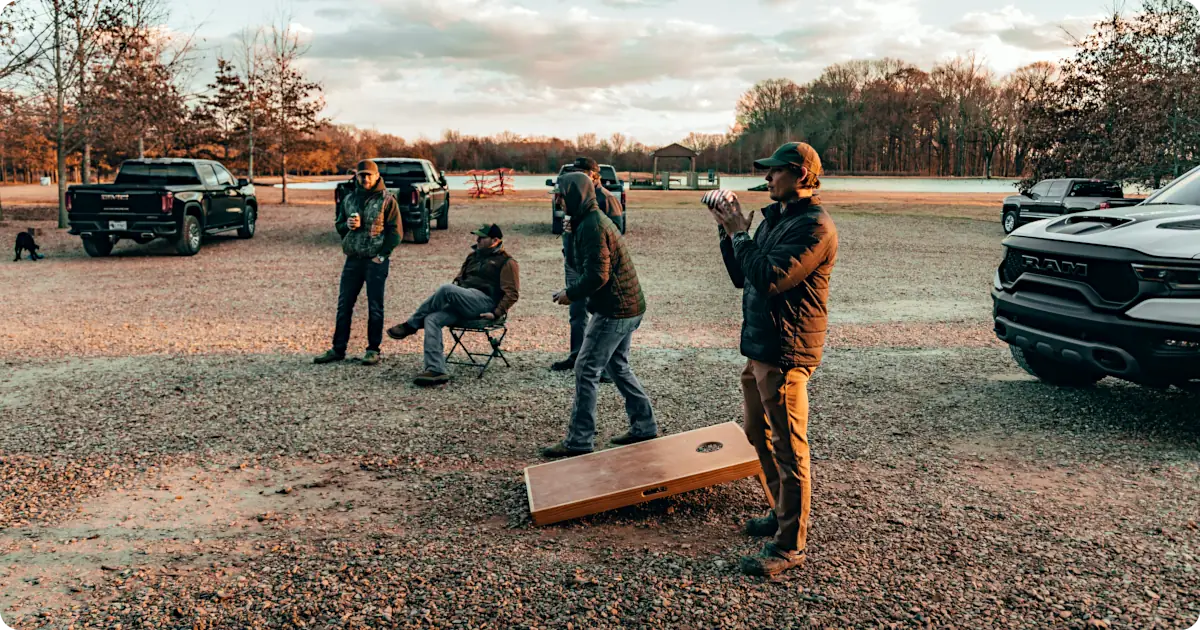Planning a backyard party or birthday bash and want a game everyone can enjoy? Learning how to play cornhole is the perfect way to add fun and friendly competition to your celebration. Cornhole, also known as bean bag toss, is easy to set up, simple to play, and great for guests of all ages.
In this post, we show you exactly how to play cornhole at a party, including rules, setup tips, scoring, and a few playful twists. We’ll also point out the differences between casual and official gameplay so you can keep it light and fun—or go full-on competitive if you choose.
How to Play Cornhole: Party-Friendly Rules Everyone Can Follow
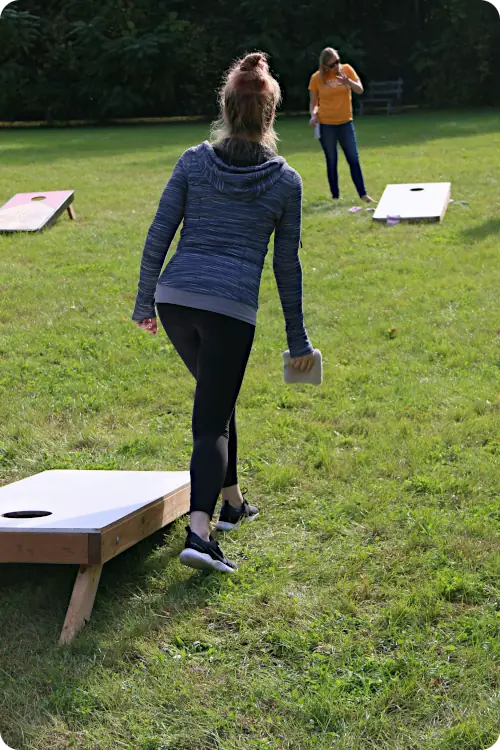
Cornhole is a lawn game where players take turns tossing bean bags at a raised board with a hole near the top. It’s often played in teams and works well for both adults and kids.
Basic Party Cornhole Game Rules on How to Play Cornhole
- Set up two cornhole boards facing each other.
- Space the boards about 20–27 feet apart (more on this below).
- Each team gets 4 bean bags.
- Players toss bags alternating turns, trying to land bags on the board or in the hole.
- After all 8 bags are thrown, scores are counted.
For a fun party vibe, you can skip strict rules and focus more on playing for fun than winning.
Don’t have a set yet? Check out our step-by-step guide on how to make a corn hole game to build your own boards and bean bags at home. It’s a fun DIY project that adds a personal touch to your party setup.
Alternatively, you may be interested in buying a corn hole board and bean bag set.
For example: GoSports 4 ft x 2 ft Regulation Size Wooden Cornhole Boards Set – Includes Carrying Case (sponsored link).
You may need to buy a separate set of bean bags. For example: Cornhole Bean Bags Set (sponsored link). Two sets of four bean bags, are needed. Preferably each team’s bean bag set is a different color from the other team’s.
Singles vs. Doubles: Understanding Player Positions in Cornhole
Cornhole is played with two boards set facing each other — but where players stand depends on whether it’s a one-on-one or team game. Here we explain how to play cornhole singles and doubles games.
Singles (One-on-One Play)
Each player throws all four of their bean bags from one end — standing next to the same board. After both players have thrown, they walk to the opposite board, count their points, and then throw back in the opposite direction for the next round.
This means both players share one board at a time, alternating throws toward the opposite board.
Doubles (Team Play)
In doubles, there are two players per team — one stationed at each board. Teammates stand at opposite ends and throw toward each other.
- Player A (Team 1) and Player B (Team 2) throw from one board.
- Their partners (Player A2 and Player B2) stand at the opposite board to receive throws, score, and then throw back in the next round.
This setup keeps the game flowing and allows continuous play without players walking back and forth after each round.
Tip: When watching cornhole tournaments or casual games online, you’ll often see two opponents side-by-side at one board — that’s a doubles match, not singles.
How Do You Set Up Cornhole for a Party?
Setting up cornhole for a party is simple and fun, but doing it right ensures everyone can play safely and enjoy the game. Whether you’re hosting a backyard BBQ, family reunion, or birthday bash, all you need is a flat surface, two cornhole boards, and a few colorful bean bags to get started.
Location
Cornhole can be played almost anywhere — indoors or outdoors — as long as you have enough space for players to throw safely. For outdoor parties, a flat backyard, driveway, or park lawn is ideal. However, if the weather turns or you’re hosting an event at a school or community center, indoor cornhole works just as well.
An open gymnasium or basketball court offers a smooth, level surface perfect for consistent throws and easy setup. The polished floor also makes retrieving bean bags effortless — no mud, no grass stains, just clean, competitive fun. Make sure to leave enough space behind each board so players can toss comfortably without crowding.
- Choose a flat backyard, driveway, or open space at your party location. Alternatively choose a large enough indoor location.
- Make sure there’s enough room for safe tossing.
Tip: If it’s a windy day, angle the boards slightly or use small weights on the legs to keep them from shifting during play.
Tip: If playing indoors, consider using soft-fill cornhole bags to prevent noise or damage to walls and floors.
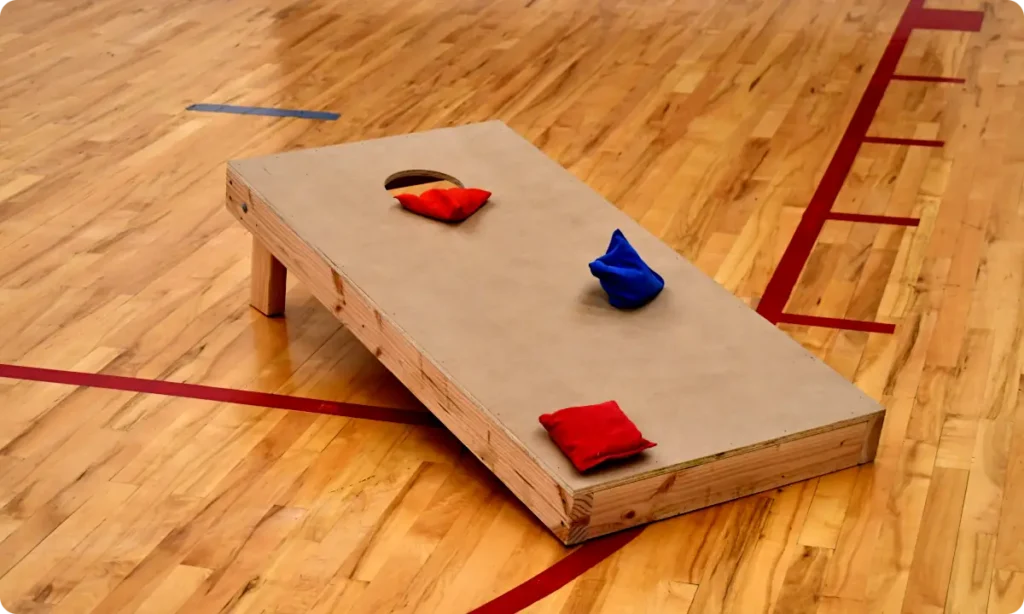
Board Placement
Board placement is key to a fair and enjoyable game. The standard distance between cornhole boards depends on whether you want casual or official play.
For backyard parties, placing the boards about 20–24 feet apart works best, especially when kids are playing. For those looking to mimic regulation play, the official distance is 27 feet front-to-front. This setup challenges players to perfect their aim—just like in professional tournaments.
If you’re wondering how far are the boards apart in cornhole, the answer depends on how official you want to get:
- Backyard parties: 20–24 feet apart works well for casual games.
- Official distance: 27 feet front-to-front (more on that in the link to our official cornhole rules article below).
Tip: Always measure the distance from the front edge of one board to the front edge of the other for consistency.
Bean Bag Setup
The bean bags are where the fun really begins! Each team should have four bags in a unique color, so it’s easy to tell who’s scoring. Regulation-size bags are typically 6 inches square and weigh around 15 ounces, filled with dried corn or resin pellets for the perfect toss.
- 4 bags per team, in two different colors.
- Bags should be around 6” square and weigh about 15 oz.
Tip: If you’re playing outdoors, choose weather-resistant bags that can handle grass, moisture, and sunlight for longer-lasting fun.
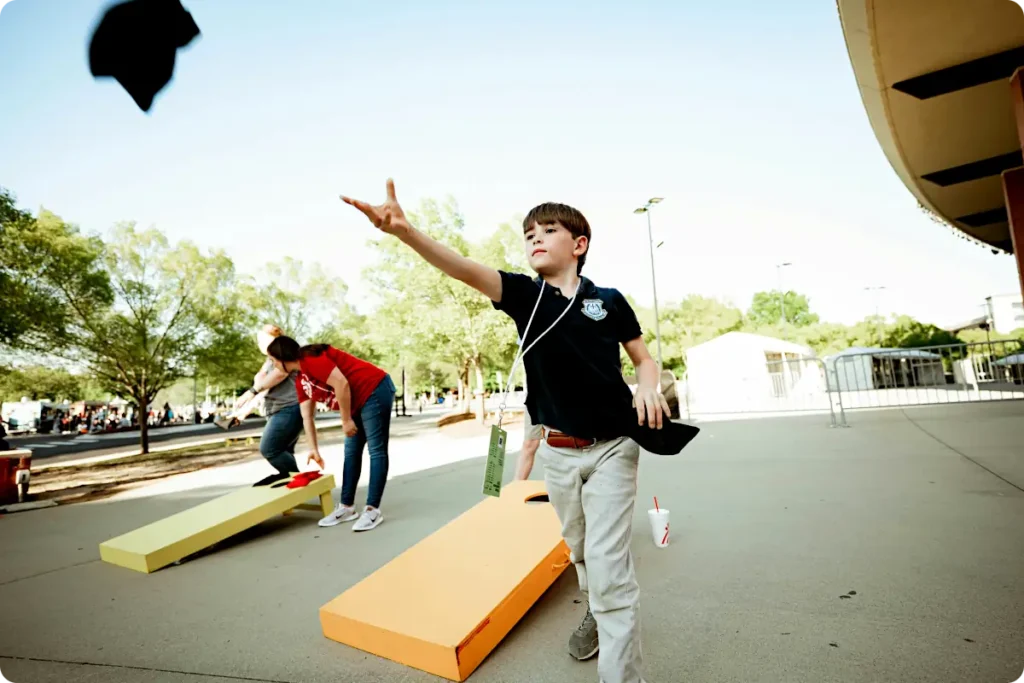
How Do You Score in Cornhole?
Scoring in cornhole is simple enough for beginners but competitive enough to keep everyone engaged. Points are awarded based on where the bags land after each round of tosses.
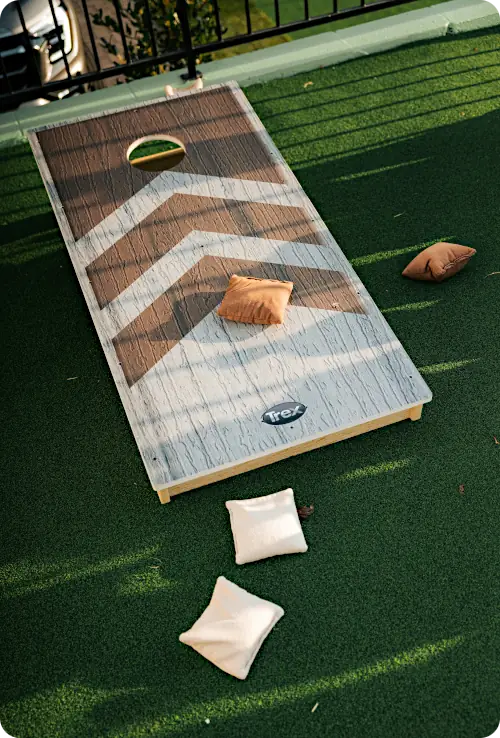
- 3 points for a bag that goes in the hole.
- 1 point for a bag that lands and stays on the board.
- 0 points for bags that hit the ground, bounce off, or slide completely past the board.
The game can be played to 21 points, or you can keep things casual and play until everyone’s had a turn. The simplicity of scoring makes it easy for players of all ages to join in without confusion.
After each round, both teams cancel out each other’s points—only the difference counts toward the total score. For example, if Team A scores 7 points and Team B scores 5, Team A adds 2 points to their overall total. The first team to reach or exceed 21 points wins the game.
Party Tip on How to Play Cornhole
Keep a chalkboard, small whiteboard, or notepad nearby for scorekeeping—or simply play by rounds for a more relaxed, free-flowing game.
How to Play Cornhole Fun Party Variations
Adding a few twists to the classic rules can make cornhole even more exciting for party guests. Whether you want a faster pace, fun obstacles, or kid-friendly challenges, these variations will keep the game fresh all day long.
1. How to Play Cornhole Rapid Fire
Turn up the energy by setting a 60-second timer and having each player toss as many bags as they can before time runs out. The player or team with the highest total score wins. It’s chaotic, competitive, and guaranteed to get everyone laughing.
2. How to Play Cornhole Obstacle Toss
Add a playful challenge by placing a lawn chair, cooler, or inflatable in front of the board to make the throws trickier. Players must arc their bags over or around the obstacle to score, adding an extra level of fun for experienced tossers.
3. Kids’ Toss Line
Keep things fair for younger players by marking a closer throwing line for kids. This adjustment keeps them engaged and gives everyone a fair shot at landing on the board. It’s a great way to make cornhole fun for the whole family.
4. Point Multiplier Rounds
Want to raise the stakes? Every third round, double the points to make comebacks possible and keep players on their toes. It’s perfect for large gatherings when you want the excitement to build as the game goes on.
Tip: Mix and match these variations throughout your party to keep the game lively and unpredictable!
What’s the Difference Between Party Cornhole and Official Cornhole?
At parties, cornhole is all about fun and flexibility. Players often adjust distances, make up “house rules,” and keep scoring casual so everyone—from kids to grandparents—can join in without pressure.
- Flexible distances
- Custom or house rules
- Lighthearted scoring
Official cornhole, on the other hand, follows strict regulations for board dimensions, bag weights, and scoring systems—perfect for competitive play or tournaments. If you’re ready to step up your game, check out the full guide on how to play official cornhole for pro-level rules, techniques, and strategy tips.
Tip: For a balanced party setup, start with casual play and gradually transition to official rules as guests get more comfortable—it keeps the competition friendly and fun!
FAQs on How to Play Cornhole
Whether you’re new to cornhole or just looking to make your next backyard game more fun, these frequently asked questions cover everything from setup to scoring.
How do you play bean bag toss?
Bean bag toss is simply another name for cornhole—they’re the same game with slightly different terminology. Players take turns tossing small fabric bags (filled with corn, beans, or synthetic pellets) toward a raised board with a hole near the top.
Each bag that lands on the board earns points, while bags that go through the hole score even higher. The goal is to outscore your opponent by the end of the game. It’s a mix of accuracy, strategy, and just enough friendly competition to make any party more fun.
Tip: For beginners, start closer to the boards and focus on your throwing technique—smooth, underhand tosses work best!
How far are the boards apart in cornhole?
The official cornhole distance is 27 feet from the front edge of one board to the front edge of the other. This is the regulation spacing used in tournaments and professional play.
For casual backyard games or family parties, you can shorten the distance to 20–24 feet, depending on available space and the age of your players. The goal is to keep it challenging but still achievable for everyone.
Tip: Use a measuring tape or pacing method to set the boards evenly. For kids, move them even closer—around 10–15 feet is perfect for younger players.
How do you set up cornhole?
Setting up cornhole is quick and easy! Place two boards on a flat surface—grass, pavement, or even an indoor hall—facing each other with the holes aligned. The boards should be slightly angled so that the back stands about 12 inches off the ground.
Each player or team stands behind their designated board when throwing. If space allows, leave at least a few feet of clearance behind and around each board to ensure safety and comfort.
Tip: If you’re playing outdoors, use stakes or small weights to prevent the boards from sliding on slick or uneven ground.
How do you score in cornhole?
Cornhole scoring is simple, which makes it easy for players of all ages to enjoy.
- 3 points for a bag that goes in the hole.
- 1 point for a bag that lands and stays on the board.
- 0 points for bags that hit the ground, bounce off, or hang halfway without staying put.
After each round, both teams cancel out each other’s points—only the difference counts toward the total score. For example, if Team A scores 7 points and Team B scores 5, Team A adds 2 points to their overall total. The first team to reach or exceed 21 points wins the game.
Tip: Keep a chalkboard or notepad handy for scoring, or use a mobile cornhole app if you want a digital option.
Is cornhole good for all ages?
Absolutely! Cornhole is one of the most family-friendly lawn games around. It’s easy to learn, requires minimal equipment, and can be adapted for all skill levels.
Kids love it because it’s simple and active, while adults enjoy the friendly competition and relaxed pace. Adjusting throwing distances makes it fair for everyone—from toddlers to grandparents.
Tip: For mixed-age groups, set up two throwing lines—one for adults and one closer for kids. You can even give prizes for the most creative throws or funniest celebrations!
What’s the best way to store cornhole boards and bags?
To keep your set in great condition, store boards indoors or under a covered area when not in use. Wipe off dirt or moisture after each game, especially if you’ve been playing outdoors. Bean bags should be kept in a dry, cool place to prevent mold or fabric damage.
Tip: Invest in a simple carrying case or tote bag for your cornhole set—it makes setup, cleanup, and transport to parties much easier.
Final Thoughts on How to Play Cornhole
Now that you know how to play cornhole at a party, you’re ready to add a fun, easy-to-learn game to your celebration lineup. Whether you’re tossing bags in your backyard or setting up for a birthday bash, cornhole brings friendly competition and lots of laughs.
Want to get serious? Read our full guide on how to play official cornhole for regulation rules and pro-level gameplay.

